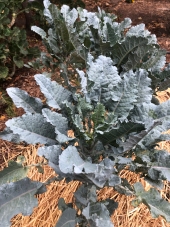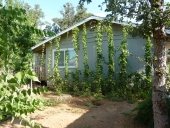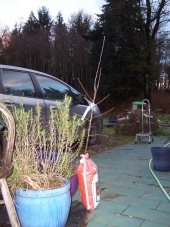









Alice Tagloff wrote:Even fully grown, 30 year old apple trees sometimes need a trellis. Even if this trellis looks more like a support jack. We have apple trees around my hometown that are older than my grandparents, and in the recent years with the warmer weather, over produce to such an extent that the fruit threatens to snap the branches off the trees.
There's one particular tree in town that has support beams under all it's limbs, literally, 4x6's, and steel jack beams in the past few years. But these beams are only necessary when there is to much fruit on the tree, or so the owner goes about it. It's a dwarf, short tree, and one year he used a car jack to shore up the lowest limb.
The scary thing about the apple trees around my hometown is that none of them are grafted, back then, people around here took what they could get, and that was the local 'farmer' starting trees from seeds, or a bored house-wife trying to grow it for a lark. So -all- the branches on all the trees around here, flower and fruit. One of oddest trees in town is this yellow apple that just might be a honeycrisp, when the tree fruits, the apples are often grapefruit sized but extraordinarily soft, even letting it fall or grabbing it to hard will bruise it. All the other trees are some variant of crabbe apple for the most part.
As for an apple tree flowering and no fruit, a single tree is probably not a cultivar(self pollinating), you often need a second tree that's male, big box stores often have no idea what they're selling when it comes to fruit trees, and the nurseries that sell to them often don't care to have grafted branches from both trees onto the rootstock, which makes the trees more expensive. The ones you tend to get from big box stores often only have two or three branches that are grafted to bare fruit, meaning that if you want to get a full blown tree with fruit all around, you eventually have to do your own grafting. And even then, you have to get your pollinators drawn to the tree, especially if it's not 'common' in your area, they don't know what it is. My parents are now finally getting apples from their trees, and it took putting planters full of lupines between the trees to get the bees to even go near them.
What you should try to get to compliment your apple tree would be a Gage tree. Green Gage's are like a cross between a plum and a Damson. They are sweet, rich in vita-c, and heavily juicy, when you bite into a properly grown Gage, your not eating your first bite, your drinking it. Around here, there used to be some Gage's, but a tree blight resulted in almost all the Damson's and Gage's getting cut down, which is a crying shame. Gage trees originated from England, so they get to be quite frost hardy. Around here, we're about zone 3/4. Damson's are a small type of plum/grape, they're like sour-tangy prunes with large stones in them. There have been years where there's no apples because of the weather, and the Damson's -always- bear fruit. They're also frost hardy, and both types of trees lend to jam and jelly making, tho you can just bottle Gage's. Gage's and Damson's are cultivars, meaning they don't need a second tree, but all cultivars do well with something of the same type around, especially each other. The ones we had in our old homestead garden, were actually planted together(like someone had a bucket of the stone pits and just dumped them down a hole to see if they'd grow), and they grew up in a big pile of multiple trunks twined together, some years you couldn't tell one fruit from the other. Tho be warned, a well-growing Gage and Damson tree will get to around 30 feet, or something with a canopy like a Dogwood, so they need their eventual space, and they're often hard to find.